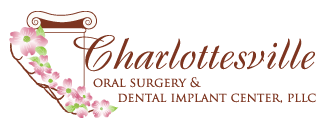Dr. Ibanez may determine that some patients are not initially good candidates for dental implants due to bone loss or other bone deficits. In such cases, bone grafting can be a valuable tool to supplement the bone tissue at the proposed implant site and allow patients to get their preferred tooth-replacement option.
Bone Grafting in Charlottesville VA
While bone grafting does result in a longer treatment timeline for dental implants, the investment of additional time produces significant rewards in greatly reducing the risk of premature implant failure.
Don’t hesitate to ask any questions that you may have about this preliminary procedure. We want to make sure that you have all of the information you need to make the best treatment decision for you.
When is bone grafting needed?
Bone grafting may be indicated prior to dental implant placement if there’s not enough bone tissue to support osseointegration. Patients with congenital bone defects may want bone grafting to correct structural or aesthetic deficiencies.
The following issues may necessitate a bone graft:
- Bone loss following tooth loss
- Congenital bone defects or developmental issues
- Bone loss resulting from facial trauma
Bone Grafting Approaches
The patient’s unique facial structures and the nature of bone loss or deficit will determine the approach to bone grafting, which may be:
- Minor bone grafting — address fairly small bone deficits
- Major bone grafting — address more substantial bone deficits and may be performed in a hospital setting with a subsequent inpatient stay
- Sinus Lift — the sinus membrane is lifted and donor bone material is inserted underneath it to provide more bone for dental implant placement at the rear of the upper jaw
- Ridge Expansion — used in fairly severe cases of bone loss/thinning of the ridge of the jaw that prohibits dental implant placement
Materials Used in Bone Grafting
Recombinant Bone Morphogenic Protein (BMP) is the protein that your own body uses to repair damage to its bone tissue. We are able to use this source as a material for bone grafting in many cases.
BMP comes in powdered form, which is inserted into your jaw. After approximately six months, the desired amount of bone is expected to form. When we use BMP in bone grafting, we can avoid using bone from another location in the patient’s body, which would require a second surgical site.
In some cases, it may be preferable to use autologous bone (from elsewhere in the patient’s body), but when appropriate, BMP can help us avoid subjecting the patient to two different incisions. We will discuss the particular considerations in your case at your consultation.
Pre-Prosthetic Preparation Surgery
Some patients may need a different type of surgery to make their facial structures more suitable to accommodate a denture, resulting in more comfort for the patient. Such pre-prosthetic preparation surgery can involve:
- Removal of excess bone
- Bone contouring and/or smoothing
- Removal of excess gum tissue
- Exposure and removal of impacted teeth
Any or all of those procedures can create a better fit between the structure of your mouth and your denture. If such surgery is indicated in your case, we will thoroughly educate you on the benefits and risks of the procedure.
Common Bone Grafting Questions
Is a bone graft necessary for a dental implant?
Successful osseointegration is the foundation of dental implant stability and longevity. Many patients will have enough bone tissue at the implant site to support osseointegration, and they will not need to undergo a preliminary bone graft. However, some patients may have insufficient bone due to loss of bone tissue after tooth loss, disease, injury, or congenital defect. In such cases, a bone graft can be a helpful procedure to supplement the bone tissue and improve the chances of successful dental implant placement.
Does bone grafting for dental implants hurt?
Any type of oral surgery is likely to result in some mild discomfort, and bone grafting is no different. However, this symptom usually can be managed with over-the-counter painkillers and/or ice packs. If you experience persistent or severe pain following your bone graft, it could be a sign of a postoperative complication, such as an infection. In such cases, patients should contact our office immediately for further evaluation and guidance.
How long does it take to heal from a bone graft?
The type of bone graft performed will dictate the anticipated recovery timeframe. For a single socket graft, patients should be able to resume most of their usual routines, except for vigorous activity, within a few days. Patients who undergo a sinus lift or ridge expansion should plan on recovery of at least one to two weeks. Keep in mind that post-graft complications could extend your recovery timeline, so you should closely follow all of our instructions for caring for the site after the graft.
What is the cost of bone graft?
The cost of a bone graft is dependent on the unique situation of each case. It may be affected by many factors including the source and site of grafted bone tissue, the amount of bone tissue that the graft requires, and the number of bone grafting sites, among other aspects of the procedure. After we evaluate your case, we will be able to give you a more precise estimate of the anticipated costs of your bone graft. We will make every attempt possible to leverage any insurance coverage that you may have to minimize your financial obligation for your bone graft.
